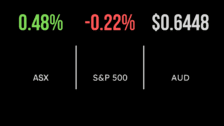Failing to pass on the full rate cut needn’t mean banks are profiteering
The unwillingness of the major (and other) banks to immediately cut their headline mortgage rates by as much as the Reserve Bank cuts its cash rate always attracts bad press, as well as condemnation from treasurers and prime ministers.
After the big four passed to variable rate owner-occupiers only 13 to 15 basis point of this month’s 25 point cut in the Reserve Bank cash rate, Treasurer Josh Frydenberg said they had decided to put profits “before their customers“, adding: “What we do expect the banks to do is to provide their customers with the best possible deal, and it’s very disappointing that they haven’t done that”
Prime Minister Scott Morrison said the banks were “basically profiteering“: “How else do you describe it? I’ve never been one, whether as treasurer or prime minister, to give the banks a leave pass”
Are the banks “profiteering”? Or are they right when they say their loan rates simply reflect their cost of funding?
‘Profiteering’ isn’t straightforward
My inquiries suggest that while there may indeed be some behaviour that could reasonably be described as profiteering, the banks’ complex funding arrangements explain much of their decisions not to pass on all of the past three interest rate cuts.
The cash rate is the rate for overnight lending between banks, and while it ultimately influences all interest rates, overnight lending and borrowing is a very small part of bank funding.
Most of the funds banks lend come from deposits and wholesale borrowings. They are typically provided for months or years rather than nights.
The rates banks pay for these funds don’t necessarily change immediately or by the same amount as the cash rate. But even when they do, the average cost of funding for bank loans changes much more slowly because it also includes the cost of funding taken out at earlier rates, until that funding is replaced by new funding taken out at new rates.
So the banks’ argument that their funding costs don’t move with the cash rate has theoretical merit. But how can we assess whether it is valid in practice?
The figures cast doubt on the “profiteering” claim
One way is to look at the behaviour of the net interest margin (NIM) of the banks. This is the difference between the amount of interest they earn on loans and other investments over and above the interest they pay on their funding, expressed as a percentage of their interest-earning assets.
If they are “profiteering” by not reducing loan rates in line with funding costs, the NIM should increase. Has this happened?
The figures suggest not – although they are not published frequently enough to give a definitive figure for developments over the past few months. Note also that there are always other factors influencing the NIM. A shift into higher risk-lending, for example, could be expected to see an increase in the NIM to reflect higher loan rates charged for greater risk.
But the figures aren’t conclusive
The net interest margins of the big four have fallen markedly since 2010 and appear to have plateaued. But that needn’t mean home borrowers are getting better deals.
The banks might be widening their margins on highly profitable home loans while narrowing them on others.
And even small changes in net interest margins (the kind not easily seen on graphs) can generate large dollar sums of the sort the banks need to offset the seemingly ever-mounting costs of compensation and fines resulting from the banking royal commission.
The difficulty of reaching a conclusion is compounded by the abundance of mortgage loan rates, such that it is the “headline” variable rate which attracts media and public attention, but which not all new borrowers pay.
Most banks offer significant discounts to new customers who are savvy enough to bargain and are good credit risks. There is not enough good contemporaneous information about what banks are charging these customers.
This isn’t to say that changes in the headline rate are unimportant. Headline rates are especially important because they apply to the mass of “back book” (existing) mortgage customers who are slow to re-bargain or refinance.
Both headline and discounted rates matter
Changes in rates on the back book matter much more for bank profits than changes in rates on the front book (new borrowers). They adjust in line with the headline rate, the ones the politicians and bank critics notice.
Unfortunately for those existing borrowers, those rates move slowly because they depend on the banks’ past funding costs. They are funded from a mix of short term and other borrowings for terms of three months to several years.
Only as that existing funding matures and banks can refinance at lower rates can the average cost of their funds decline – and even then not generally by as much as the cash rate. Bank average funding costs are necessarily less variable than the cash rate, such that even over time after long lags we can’t necessarily expect their headline rates to track the cash rate.
Of course, it would be foolish to rule out the possibility that the major banks, all wearing costs as a result of the royal commission, are attempting to recoup some of those costs by a less than complete pass-through of their average funding costs.
If they are, the offerings of alternative mortgage providers with different funding models will be become relatively more attractive and there will be more in it for customers who switch.
Ultimately, it’s customer awareness and action that will inhibit bank “profiteering”, far more than jawboning by politicians and the media.
Kevin Davis is professor of finance at the University of Melbourne
The article was first published in The Conversation
The unwillingness of the major (and other) banks to immediately cut their headline mortgage rates by as much as the Reserve Bank cuts its cash rate always attracts bad press, as well as condemnation from treasurers and prime ministers.










